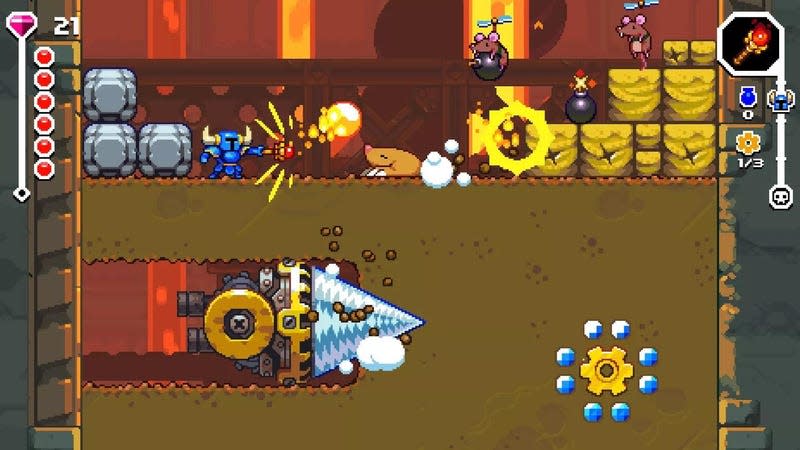Shovel Knight: Dig is a fascinating evolution of an indie game favorite

Every Friday, A.V. Club staffers kick off our weekly open thread for the discussion of gaming plans and recent gaming glories, but of course, the real action is down in the comments, where we invite you to answer our eternal question: What Are You Playing This Weekend?
When Shovel Knight first came out back in June of 2014, it did so at what felt like the forefront of a new wave of indie gaming. Designed by Yacht Club Games, the brightly colored platformer was an early success of the Kickstarter game development movement, successfully blending old-school NES-style jumping and slashing—including a very direct crib of the very good pogo-stick jumping mechanics from Capcom’s classic DuckTales game—with modern ideas about game design. (There’s even some Dark Souls in there, if you squint.) It was also one of the first games to, let’s say, weaponize the 8-bit art style of yesteryear for a combination of aesthetic and nostalgic triumphs, helping to kick off 8 million arguments about the merits of said look. (And also, like, six billion grumbling asides from my colleague Sam Barsanti, every time we talk indie games.)
Read more
A definitive but possibly questionable ranking of festival films, according to standing ovations
What to watch on Apple TV Plus: 14 best shows streaming right now
Eight years later, though, the interesting thing about Shovel Knight isn’t how it looks, or even how it plays—although it still plays smooth, I’m happy to report. No, what’s interesting about Shovel Knight in 2022 is how Yacht Club has worked to expend it beyond one game into a whole franchise, despite having only released three actual games to date—with the latest, Shovel Knight: Dig, a joint production with Nitrome, arriving on Steam, Switch, and Apple Arcade last week.
Shovel Knight Dig Trailer
Dig is a strange beast, the latest in a long line of developers trying to take an existing gameplay structure and translate it into the world of the super-trendy roguelike genre—i.e., that now-extremely reliable way to boost up a game’s playtime by bolting in some computer-generated levels, some “play it just one more time, okay?” progression schemes, and the thrilling possibility of losing a bunch of progress when you die. Shovel Knight, a consistent triumph of level design, is, on first blush, an odd candidate for this sort of transfusion. The solution appears to have been to, uh, homage another roguelike classic—in this case, Ojiro Fumoto’s brilliant Downwell—and combine it with a computer-assembled map of individual rooms that all bear the design hallmarks of Yacht Club’s smart, challenging approach to level building. The result is interesting, even when it frustrates, or when it clearly stretches the limits of this “roguelike-it-up!” approach.
The strangest thing about Dig, though, is the very fact of its release as a standalone product at all. Shovel Knight is, after all, one of the most expanded indie games of all time; the Treasure Trove version of the game now sports four full-length games within its vast archives, with the latter three campaigns— “Plague Of Shadows,” “Specter Of Torment,” and “King Of Cards”—rolling out slowly over the last several years, each arriving with a new story, new gameplay mechanics, and even, in the case of “King,” a brand new collectible card game for players to lose their minds over. (And even here, I’m glossing over the additional multiplayer fighting game mode!)
From a business point of view, this amount of post-release support was frankly kind of ludicrous—an outgrowth of a now-passed era in which plucky developers sought to outdo each other in how extensive and grand their Kickstarter stretch goals could be. From a player point of view, it was much more simple to parse as an amazing act of generosity; it was genuinely wonderful to check back in on Shovel Knight every year or so and find a whole new campaign to get through. (Nobody can quibble that they didn’t get their money’s worth with that package—or begrudge Yacht Club for actually trying to, y’know, sell a new video game at last.) And from a development point of view …well, from a development point of view, it made Yacht Club Games extremely good at making Shovel Knight.
Because while you can quibble with some of the top-level design decisions on display in Dig—the power-up economy, which is one of those things vital to ensuring the feeling of growth in a good roguelike, is messy as hell, to name just one—it’s very hard to argue with the basic mechanics of digging, slashing, and bouncing your way down through its endless levels. One of the great things about the various Shovel Knight campaigns was the way that each of the main playable characters interacted with jumping in different ways, transforming that most basic verb of platforming each time. (Plague Knight, for instance, launched himself explosively, while King Knight slammed himself into walls to get a little air.)
In returning to Shovel Knight’s basic shovel bounce—and, in a clever move, making it mandatory any time you leap—the devs display their hard-won ability to make a complex, physics-y puzzle game out of the basic building blocks of a platformer. There’s even a bit of Tony Hawk mixed in here, with gems or enemy placements encouraging players to think of these less as rooms to traverse, and more lines and combos to master. It’s thrilling on the micro level, even if the macro leaves something to be desired—and it’s hard to imagine pulling that off without the long, strange route the developers took to get here.

